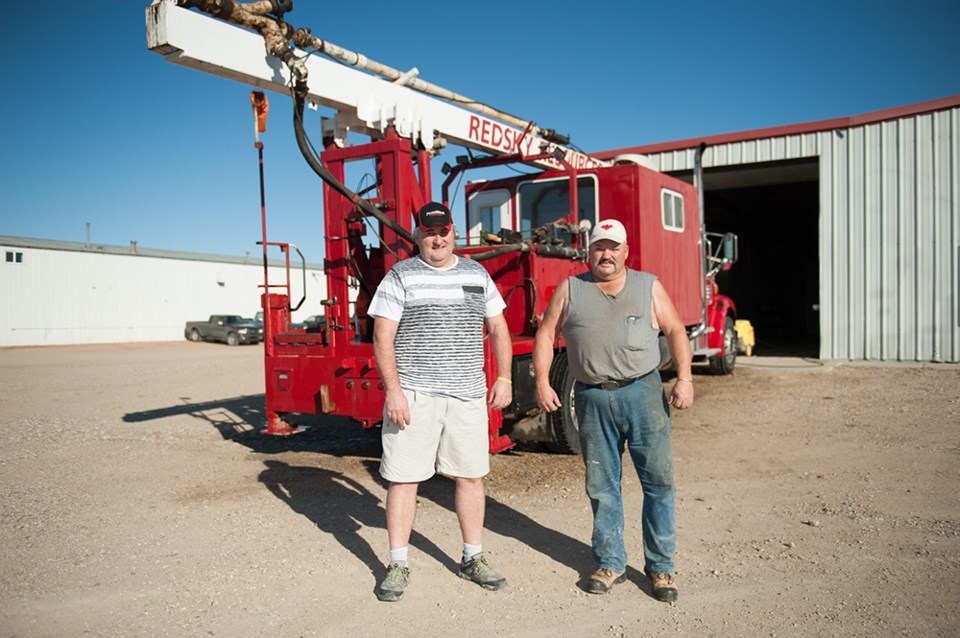Kindersley– When an oil well is near the end of its productive life, but not quite there yet, often several more years can be wrung out of it before abandonment. That’s where a process known as swabbing comes into play. For Jim Olson, he’s been doing it since September 1989.
Jim Olson owns and operates Red Sky Resources Ltd. with his brother Gregg “Butch” Olson, along with their respective wives Brenda and Dawn. Jim runs the office and goes out in the field from time to time, while Gregg handles a lot of the repair.
“That’s basically what started the industry we’re in, swabbing, was a downturn like this one,” Jim Olson said. “They were stripping off these real marginal wells.
“A lot of companies were going broke. They start stripping off wells, selling equipment. They were giving wells away, selling them for a buck. You didn’t have to worry about the abandonment,” he explained. It wasn’t viable to keep paying for operators to maintain those wells.
By swabbing them once or twice a week, those wells kept going. “Some of them, you’ll get anywhere from 0.3 of a cubic metre to 2.5 cubic metres off them, depending on the well,” Olson said.
“The production swabbing we do is pretty unique to this area,” he said. “We don’t just swab oil wells. We swab water off gas wells.”
The process of swabbing is not too far off from the concept of lowering a bucket by rope into a water well then pulling it up.
“The tool we run down the hole has swab cups on it – rubber rings,” he said.
There are holes through the tool at the top and middle. The cups slide up, allowing the tool to drop through the fluid. Once you are at the bottom of the well or as deep as you want to go, engaging the drawworks tightens the cable. The cups seat on the bottom and pull up the fluid with it – just like a bucket full of water.
A three-inch hose comes off the lubricator off the top. All the fluid goes into the tank on the truck. “It’s pretty much a portable pumpjack on a truck, basically.”
“In oil wells, it’s mostly oil,” he said.
The process is pretty quick, as Olson noted they can do one-to-three wells in an hour, depending on the wells.
“You back into the well, you stand your pole. You’ve got a four-inch valve on the well. You spin a half-thread in for a hammer union. Our lubricator goes on. You hammer that in, tight. You open the valve, lift your brake and run ’er down.
“The wells are basically dead. There’s little to no gas. We have a depthometer that tells you how deep you are. Most of the stuff we’re swabbing is about 680 to 720 metres down the well. They’re mostly old verticals.
“When you’re done, you shut the valve on the well, unhook the lubricator and go to the next well. Most of our tanks are six cubic metres of fluid. You go until you’re full. You go to the battery or field tank to unload.”
“It’s just a matter of keeping producing them when there’s nothing to pump anymore. Most of these are a barrel-a-day wells. They’ve reached the end of their life and they’re kind of oozing in there. That’s why they’re not viable for the power for the pumpjack or the operator to check on it.”
The work is usually done on a contract basis, by the hour or by the swab.
Their rigs are very similar to flushby units, but smaller. Most of Red Sky’s units are single axel trucks with a small drawworks, pull mast and tank.
Sometimes if a well doesn’t flow after a frac, they’ll be called in to swab the water out of the well to get it going. “They’ll go from dead to live really quick,” Olson said.
Due to the low price of gas, swabbing gas wells has dropped off substantially. “For gas wells, the last two years have been nonexistent. (Given) the price of gas, if the well loads up, they shut it in,” he said.
Gas wells need swabbing when the water in the well loads up to a point where the gas won’t flow anymore.
While some people might think swabbing is on its way out, Olson countered, “I’ve been hearing that since I started nearly 30 years ago.”
Liability ratios for keeping old wells active versus abandoning and cleaning them up is a growing issue for the industry. Olson said, “My take on that is they all have to be abandoned at some point. But for these companies, whether they keep swabbing them or abandoning them … if they’re still profitable as you’re swabbing them, why would you abandon them?”
“That’s basically what started our industry. As an alternative to abandoning a well, let’s keep making money. The RMs are collecting taxes off it. The farmers are collecting lease payments. We’re employing people to run equipment to do it. It keeps money in the area.
“But there is a point where some stuff just isn’t profitable, where you have to abandon that stuff and plug it.”
The Kindersley area has hundreds of old vertical wells that are swabbed. The bulk of their work is between Kindersley and Kerrobert, but they also work in the Plato area.
Red Sky runs seven swabbing rigs and has nine employees. Each rig usually has just one worker, unless they are working on a gas well, then they would have two.
The business stays fairly steady all the time, whether the price of oil is high or low. “It’s pretty consistent. Compared to a lot of other sectors in the oilfield, we’ve been fortunate,” Olson said.
While things have slowed down and they’ve had to cut rates, they’ve actually just hired another worker, allowing them to reactivate a unit that had been idled for a year.




